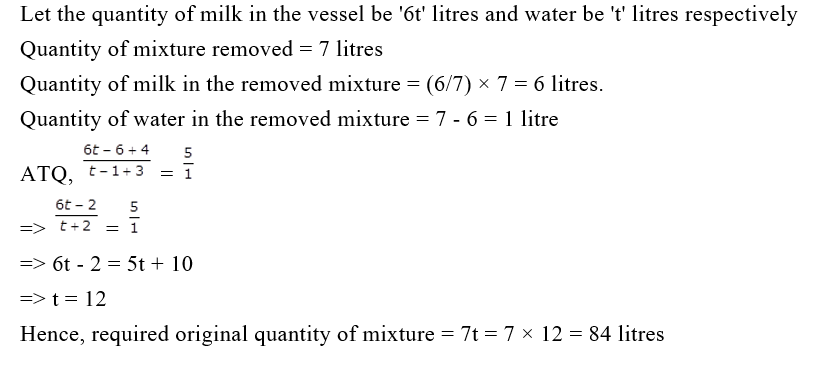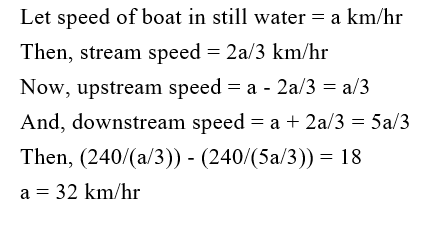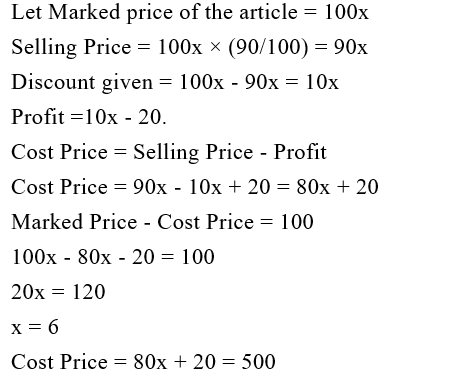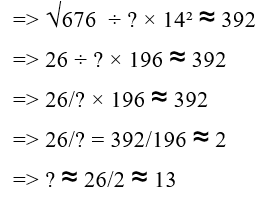Question 1:
A man invested Rs 18400 in two equal parts on SI for N years and (N+3) years at the rate of 20% per annum and 10% per annum respectively. If the man got a total interest of Rs 8280, then the value of N is:
एक व्यक्ति साधारण ब्याज पर N वर्ष और (N+3) वर्षों के लिए क्रमशः 20% प्रति वर्ष और 10% प्रति वर्ष की दर से दो बराबर भागों में रु. 18400 का निवेश करता है। यदि व्यक्ति को कुल रु. 8280 का ब्याज प्राप्त होता है, तो N का मूल्य कितना है?
Question 2:
A vessel contains milk and water in the ratio 6:1. If 7 litres of the mixture is removed and 4 litres of milk and 3 litres of water is added to the vessel, the quantity of milk in the vessel becomes 400% more than that of water. Find the original quantity of mixture (milk and water) in the vessel (in litres).
एक बर्तन में दूध और पानी का अनुपात 6: 1 है। यदि इस मिश्रण में से 7 लीटर मिश्रण निकाल लिया जाता है तथा बर्तन में 4 लीटर दूध और 3 लीटर पानी मिला दिया जाता है, तो बर्तन में दूध की मात्रा, पानी की मात्रा से 400% अधिक हो जाती है। बर्तन में मिश्रण (दूध और पानी) की मूल मात्रा (लीटर में) ज्ञात कीजिए।
Question 3:
A boat takes some time to cover a distance of 240 km and takes 18 hours less to return back. If speed of stream is 2/3 times speed of boat in still water, then find the speed of boat in still water.
एक नाव को 240 किमी की दूरी तय करने में कुछ समय लगता है और वापस लौटने में 18 घण्टे कम लगते हैं। यदि धारा की गति, स्थिर (शांत) पानी में नाव की गति से 2/3 गुना है, तब स्थिर पानी में नाव की गति ज्ञात कीजिए।
Question 4:
Monthly income of P, Q and S are in the ratio (1/3): (1/7): (5/21) respectively. If Q earns Rs.5000 less than S every month, then find P's yearly income.
P, Q और S की मासिक आय का अनुपात क्रमशः (1/3) : (1/7) : (5/21) है। यदि Q प्रत्येक महीने में S से रु. 5000 कम अर्जित करता है, तो P की वार्षिक आय ज्ञात कीजिए।
Question 5:
X invested Rs.1500 in a business. Y invested Rs.2000 for 12 months. X invested for half the time period of Y. After 1 year Y received some profit which is Rs.700 less than the investment of X. Find total profit.
X ने एक व्यवसाय में रु.1500 का निवेश किया। Y ने 12 महीने के लिए रु.2000 का निवेश किया। X ने Y की आधी समयावधि के लिए निवेश किया। 1 वर्ष के बाद Y को कुछ लाभ प्राप्त हुआ जो X के निवेश से रु.700 कम है। कुल लाभ ज्ञात कीजिए।
Question 6:
A shopkeeper gives a discount of 10% on the marked price of an article. The profit that he obtained is Rs.20 less than the discount, difference between Marked price and Cost Price is Rs.100. Find Cost price?
एक दुकानदार एक वस्तु के अंकित मूल्य पर 10% की छूट प्रदान करता है। उसके द्वारा अर्जित लाभ, प्रदान की गई छूट से रु. 20 कम है तथा अंकित मूल्य और क्रय मूल्य के बीच का अंतर रु. 100 है, तो क्रय मूल्य ज्ञात कीजिए?
Question 7: 
Question 8: 
Question 9:
Direction: What approximate value will come in place of question mark (?) in the following question?
निर्देश : निम्नलिखित प्रश्न में प्रश्न चिह्न (?) के स्थान पर अनुमानित मान क्या आएगा?
? × 4.11 = 45.001 × 4.02 + 17.87/2.01
Question 10: 







